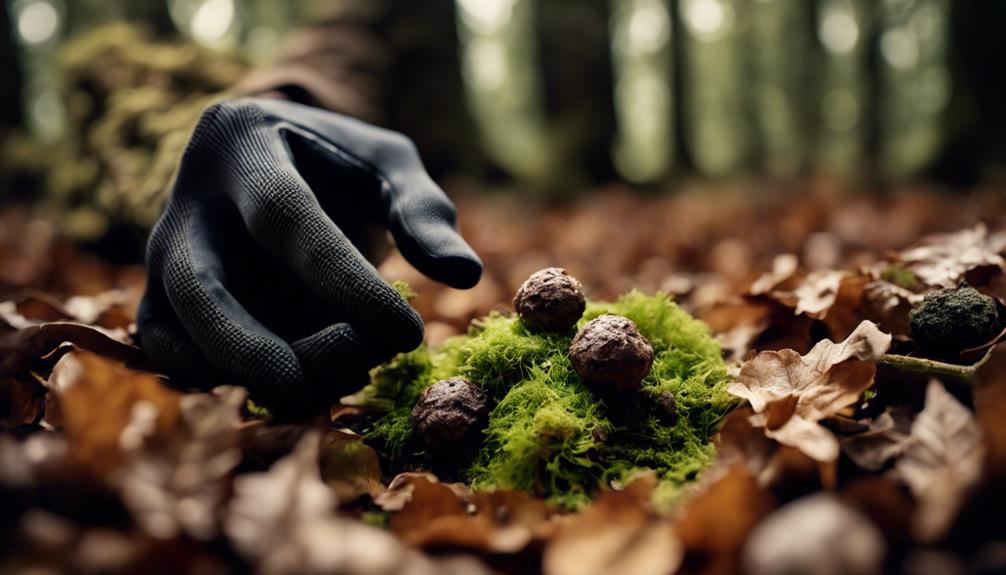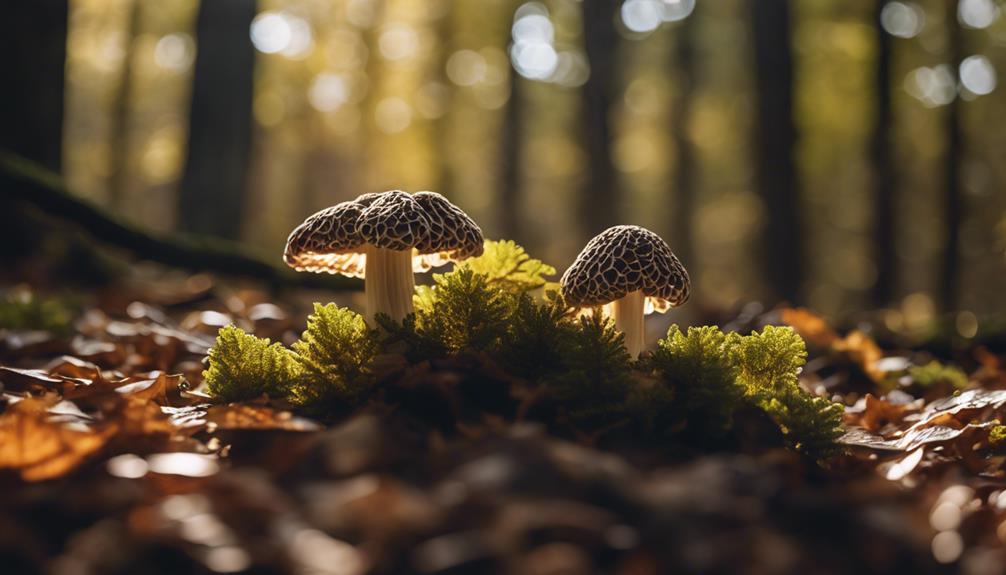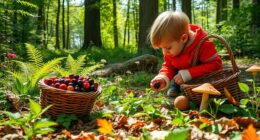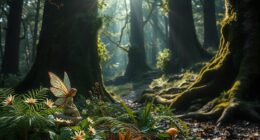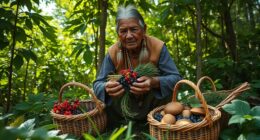Embark on the ultimate truffle hunting adventure with a detailed guide. Learn the essentials, identify different species, and choose the right tools. Discover prime truffle locations based on soil and climate conditions. Study growth patterns and prepare carefully. Harvest ethically to protect the fragile ecosystem. Store truffles properly for future culinary creations. Dive into cooking with truffles to enjoy their unique flavor. Uncover the mysteries of this respected tradition and reap the rewards of your efforts. Hone your truffle hunting skills and enhance your culinary pursuits. Share additional tips for success in the exciting world of truffle foraging.
Key Takeaways
- Research truffle growth factors and local species.
- Equip yourself with truffle hunting tools.
- Locate truffle hotspots with ideal conditions.
- Understand truffle growth and symbiotic relationships.
- Harvest ethically and preserve truffles correctly.
Truffle Hunting Basics
How can you effectively prepare for a successful truffle hunting expedition?
Before starting on your truffle hunting adventure, it's a good idea to invest a lot of time in research. Understanding the factors that contribute to truffle growth, such as altitude, exposure, shade, rainfall, tree species, soil composition, and pH levels, will help you identify suitable locations for your hunt.
Take the time to research truffles in your specific area and learn about their growth times to maximize your chances of success.
To guarantee a fruitful truffle hunting experience, meticulous planning is essential. Approach the hunt like a detective, piecing together information to identify potential hunting sites. Working with a trained truffle dog can significantly enhance your chances of finding these elusive fungi.
Make sure to arm yourself with knowledge, patience, and a sense of adventure to fully enjoy the challenge of truffle hunting. By embracing the natural experience of the hunt, you can make the most of this unique foraging opportunity.
Identifying Truffle Species
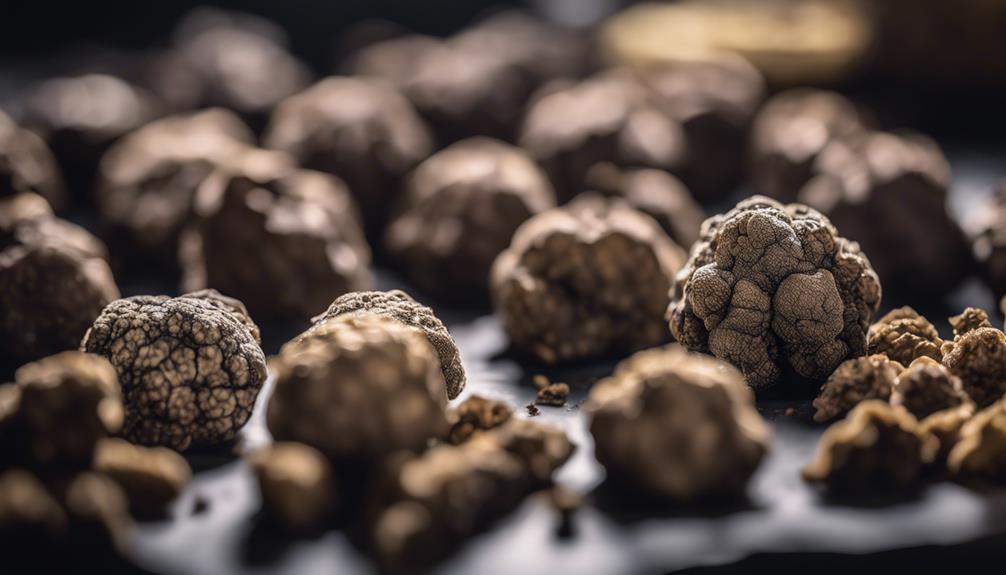
To successfully hunt for truffles, it's important to first be able to identify the different species that exist, as each species has unique characteristics and specific habitat requirements. Truffle species include the highly prized Perigord black truffle (Tuber melanosporum) and the white truffle (Tuber magnatum).
Other notable species are the Burgundy truffle (Tuber aestivum) and the Oregon white truffle (Tuber oregonense). These species vary in appearance, aroma, flavor, and the trees they associate with for growth. Identifying truffle species is essential as each one thrives in distinct habitats, which impacts where you should search for them.
Understanding the characteristics and habitats of different truffle species is vital for effective truffle hunting. By familiarizing yourself with the unique traits of each species, you increase your chances of successfully locating these elusive culinary treasures in the wild.
Choosing the Right Tools
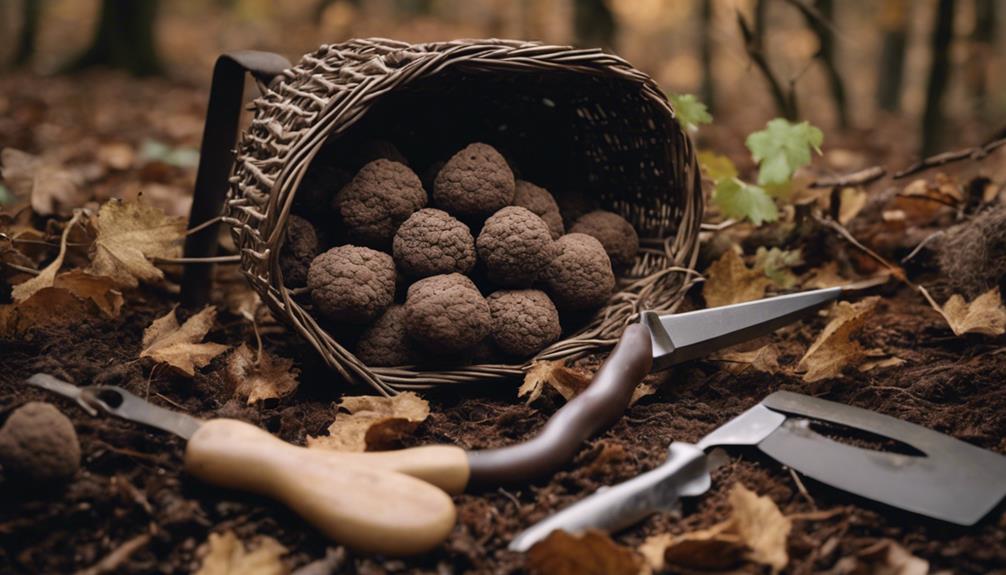
Invest in essential tools like a reliable truffle dog, a durable hunting rake, and a sharp knife for successful truffle hunting expeditions.
A well-trained truffle dog is invaluable, using its keen sense of smell to locate truffles hidden beneath the soil.
When it comes to unearthing truffles, a sturdy truffle hunting rake with prongs or a small hand rake is ideal for gently extracting truffles without causing damage.
To guarantee precise harvesting, consider using a truffle hunting knife with a curved blade, allowing for clean cuts and careful removal of truffles from the ground.
Remember to bring along a sturdy basket or bag to safely store harvested truffles without crushing or bruising them.
Additionally, dress appropriately for your truffle hunting adventure, considering the terrain and weather conditions in truffle habitats to make sure a comfortable and successful expedition.
With the right tools in hand, you'll be well-equipped to set off on a fruitful truffle hunting journey.
Locating Truffle Hotspots
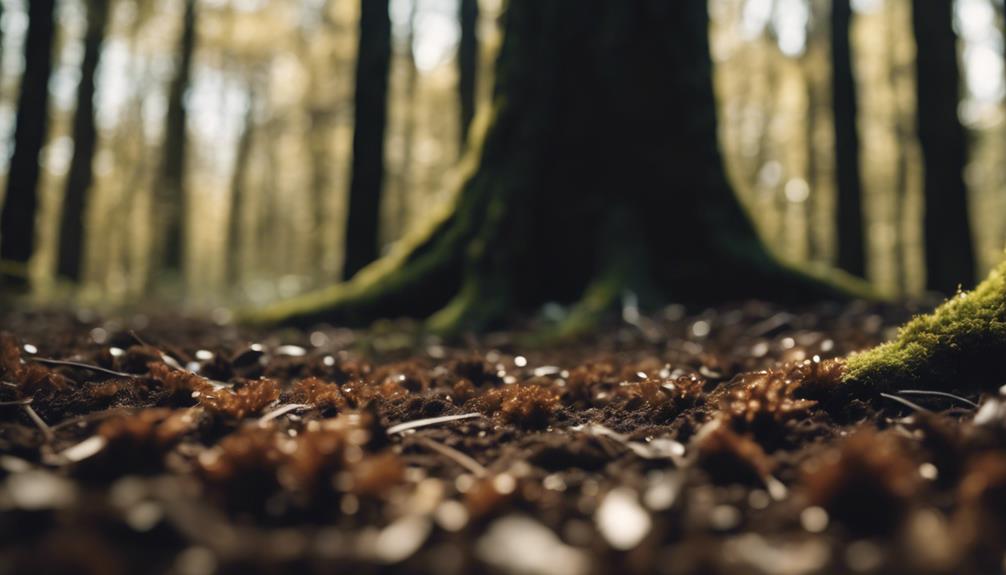
When searching for truffle hotspots, pay attention to the soil and climate conditions in the area. Truffles thrive in specific environments influenced by factors like altitude, rainfall, and pH levels.
Additionally, the symbiotic relationship between truffles and certain tree species is essential for their growth, so keep an eye out for areas with diverse plant life to maximize your chances of finding these elusive fungi.
Soil and Climate
Explore truffle hotspots by examining the soil composition and climate factors that contribute to ideal growth conditions for these prized fungi.
Truffles thrive in well-drained, calcareous soils with good aeration, often found in areas with oak, hazelnut, beech, or pine trees. Peak growth occurs in regions with mild, Mediterranean climates, featuring hot, dry summers and cool, wet winters.
Truffle hotspots typically have a pH level between 7.5 and 8.3, creating excellent conditions for truffle mycorrhizae to develop and fruit. Prime locations for truffle growth are found at altitudes ranging from 200 to 800 meters above sea level.
Success in truffle hunting is closely tied to identifying regions with the right soil composition, climate patterns, vegetation, and elevation for superior truffle production. By understanding these soil and climate factors, you can pinpoint truffle hotspots and increase your chances of a successful foraging experience.
Tree Symbiosis
To locate truffle hotspots effectively, focus on the symbiotic relationship between truffles and specific tree species like oaks, hazelnuts, and beech trees. These trees play an essential role in supporting truffle growth by providing necessary nutrients and protection. When searching for truffles, keep these tree species in mind as they serve as key indicators of potential hunting grounds.
Here's how you can leverage tree symbiosis to enhance your truffle hunting experience:
- Identify the Right Trees: Look for oak, hazelnut, and beech trees in the area as they're known to form symbiotic relationships with truffles.
- Observe Tree Health: Healthy, mature trees are more likely to host truffles, so focus your search around thriving specimens.
- Check Soil Conditions: Trees in well-drained, calcareous soils are ideal for truffle growth, so pay attention to the ground composition.
- Explore Diverse Habitats: Different tree species thrive in various environments, so explore a variety of locations to maximize your chances of finding truffles.
Understanding Truffle Growth
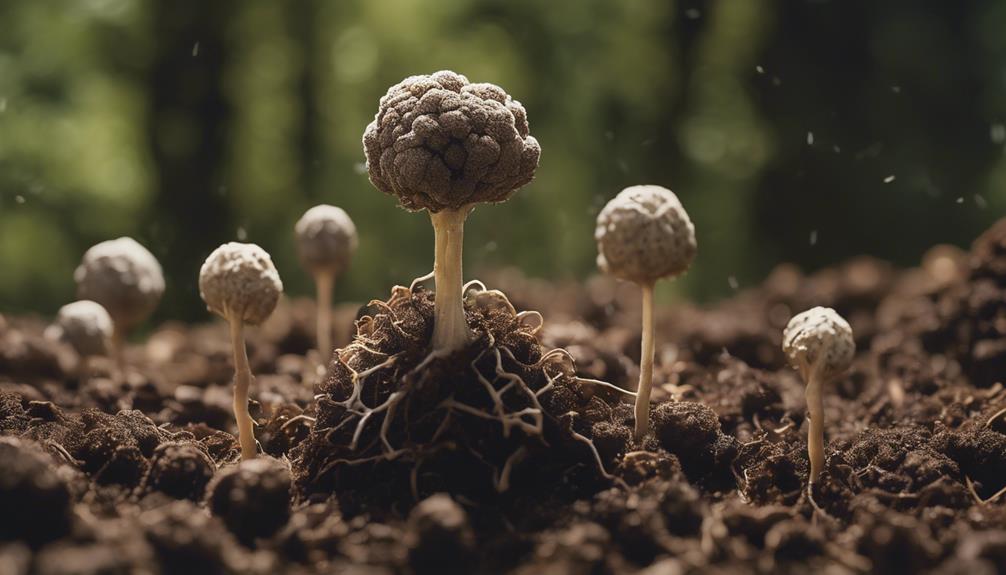
Truffle growth is influenced by various environmental factors such as altitude, exposure, shade, rainfall, tree species, soil composition, and pH levels. These elements are essential for creating the optimal conditions for truffles to thrive.
Symbiotic relationships with specific vegetation are also critical for their growth, emphasizing the importance of locating areas with the right mix of factors.
When seeking out truffles, it's important to research potential locations thoroughly, take meticulous notes, and use binoculars to scan for signs of truffle presence. This preparation greatly increases your chances of success when hunting for these elusive fungi.
Training Your Truffle Dog

Begin by consistently training your truffle dog to detect the scent of ripe truffles underground. This process is essential in developing a reliable truffle hunter.
Here are some key steps to effectively train your truffle dog:
- Introducing the Scent: Familiarize your dog with the unique aroma of truffles by using scented oils or pieces of truffle to associate the scent with a reward.
- Rewarding Success: When your dog successfully locates a truffle, reward them with treats or praise to reinforce the behavior.
- Practice Makes Perfect: Regular training sessions in various environments will help sharpen your dog's truffle hunting skills and build confidence.
- Consistency is Key: Maintain a consistent training schedule and approach to make sure your dog understands what's expected of them during truffle hunts.
Planning Your Truffle Hunt

To plan your truffle hunt effectively, start by researching and selecting potential hunting locations that are known for truffle growth.
Make sure to equip yourself with essential tools like a detailed notebook to record observations and binoculars to scout areas from afar.
Choosing Hunting Locations
Consider carefully researching potential truffle hunting locations based on factors like altitude, tree species, and soil composition to maximize your chances of a successful hunt. To choose the best hunting spots, follow these steps:
- Detailed Research:
Before setting out, study the terrain, altitude, and types of trees in the area. Truffles favor specific environments, so understanding these factors can lead you to promising locations.
- Notebook:
Keep a detailed notebook to jot down observations, potential sites, and any clues you discover during your research. This will help you track your progress and revisit promising spots.
- Binoculars:
Invest in a pair of binoculars to scout for signs of truffle growth from a distance. Look for specific tree species, mycorrhizal fungi, or signs of soil disturbance, which can indicate truffle presence.
- Strategic Thinking:
Approach truffle hunting like a detective, piecing together clues and factors that may lead you to successful hunting grounds. Think methodically and be prepared to explore multiple locations to increase your chances of a find.
Gathering Necessary Tools
Invest in a quality truffle dog or train your own canine companion for truffle hunting to enhance your chances of a successful hunt.
A well-trained dog with a keen sense of smell can greatly improve your truffle hunting experience.
Additionally, consider purchasing or making a truffle hunting rake. This tool is designed to gently unearth truffles without causing damage.
Remember to bring a small basket or mesh bag to store the truffles you find during your hunt.
To keep track of where you find truffles, using a GPS device or smartphone app to mark locations can be invaluable.
Don't forget to pack a small shovel or trowel as well. These tools are essential for digging around tree roots, where truffles are commonly hidden.
Harvesting Truffles Ethically

Harvest truffles ethically by utilizing trained truffle dogs to locate them without causing harm to the underground mycelium network. By following these guidelines, you can guarantee a sustainable harvest while preserving the delicate truffle ecosystem:
- Use Truffle Dogs: Employ well-trained truffle dogs to sniff out mature truffles without disturbing the soil or damaging the mycelium network.
- Avoid Digging Tools: Refrain from using rakes or shovels to unearth truffles as these tools can harm the truffle habitat and reduce future yields.
- Harvest Mature Truffles: Only pick truffles that have fully developed their aroma and flavor, leaving immature ones to mature and spread spores for future growth.
- Follow Regulations: Adhere to local guidelines and regulations for truffle harvesting to promote sustainability and protect truffle populations.
Storing and Preserving Truffles
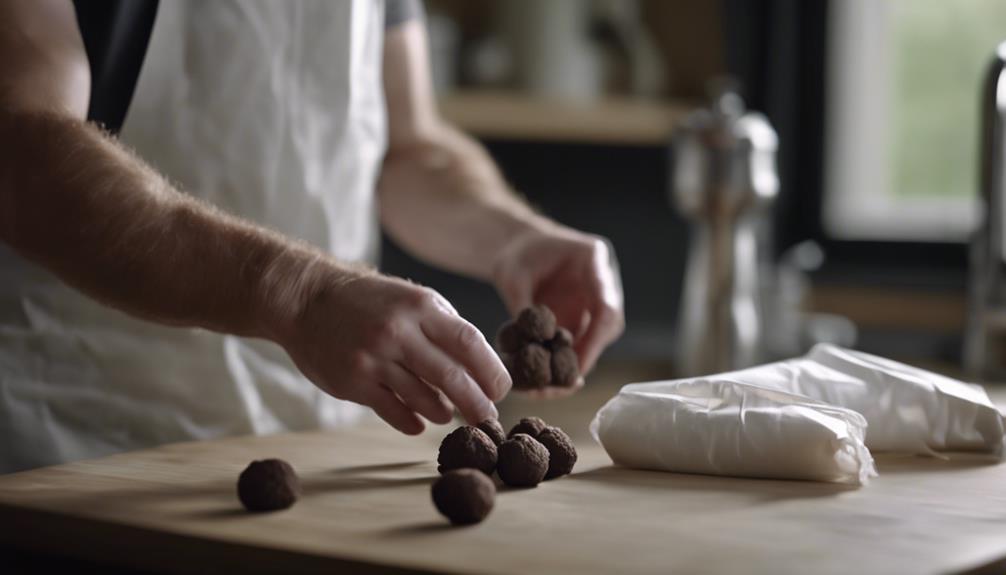
To guarantee the best flavor and longevity of your truffles, proper storage and preservation techniques are essential. Fresh truffles can be stored in the refrigerator for up to one week to maintain their freshness.
For longer preservation, consider storing them in a jar of arborio rice, changing the rice every few days to absorb excess moisture and prevent mold growth.
If you want to freeze your truffles, grate or slice them first, then place them in an airtight container or vacuum-sealed bag to maintain their flavor and texture.
Additionally, you can extend the shelf life and enhance the flavor of your truffles by making truffle butter or oil. These infused products can be stored in the refrigerator or freezer for an extended period, allowing you to enjoy the unique taste of truffles in various dishes.
Remember to use airtight containers, rice, or freezing methods to preserve your truffles effectively for future culinary adventures.
Enjoying the Fruits of Your Labor

Enhance your culinary creations with the exquisite flavors of truffles, elevating dishes with their distinctive earthy notes and luxurious taste.
Once you have successfully harvested these culinary gems, it's time to enjoy the fruits of your labor.
Here's how you can make the most of your truffle hunting experience:
- Savor the Unique Flavors: Incorporate truffles into your cooking to enhance dishes with their earthy aroma and rich taste.
- Explore Versatile Recipes: Experiment with truffle-infused oils, decadent truffle risottos, or even simple dishes like scrambled eggs for a gourmet touch.
- Share the Joy: Invite friends and family to join in the truffle experience, creating lasting memories and bonding over the thrill of the hunt.
- Promote Sustainability: Promote the preservation of truffle ecosystems by practicing sustainable harvesting methods, contributing to the longevity of this ancient tradition.
Frequently Asked Questions
How Do You Start Truffle Hunting?
Start truffle hunting by researching truffles in your area, locating suitable spots, and investing in tools like binoculars. Take notes to track findings, think like a detective, and enjoy the hunt with your dog for a rewarding experience.
Can You Go Truffle Hunting in the Us?
Yes, you can go truffle hunting in the US! Explore regions like Oregon, California, North Carolina, and Tennessee for this unique experience. Truffle farms offer guided hunts, allowing you to discover diverse truffle species and habitats.
Do Truffle Hunters Make Good Money?
You bet truffle hunters make good money! With earnings ranging from $30,000 to over $100,000 annually, skilled truffle hunters can strike gold in the forest. Finding those prized fungi could mean cashing in big time.
How Do You Know Where to Dig for Truffles?
To find truffles, look near specific trees like oaks or hazelnuts. Search for signs of animal activity, check the soil type, and spot mycorrhizal plants. Truffles grow close to the surface, within the top 10-20 cm.
Conclusion
Now that you have all the tools and knowledge needed to hunt for truffles, you may be thinking it's too difficult or time-consuming. But remember, the rewards of finding these elusive treasures are well worth the effort.
So don't be discouraged by the challenge, embrace it and enjoy the satisfaction of discovering nature's hidden gems.
Happy hunting!

